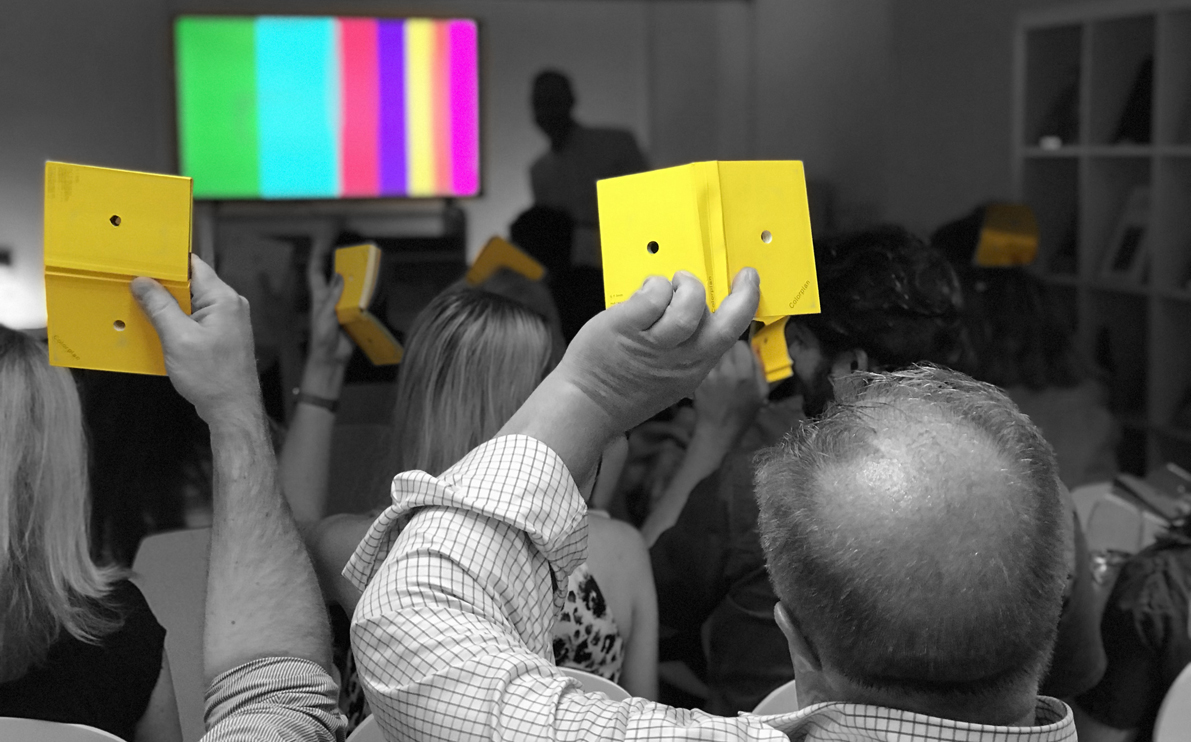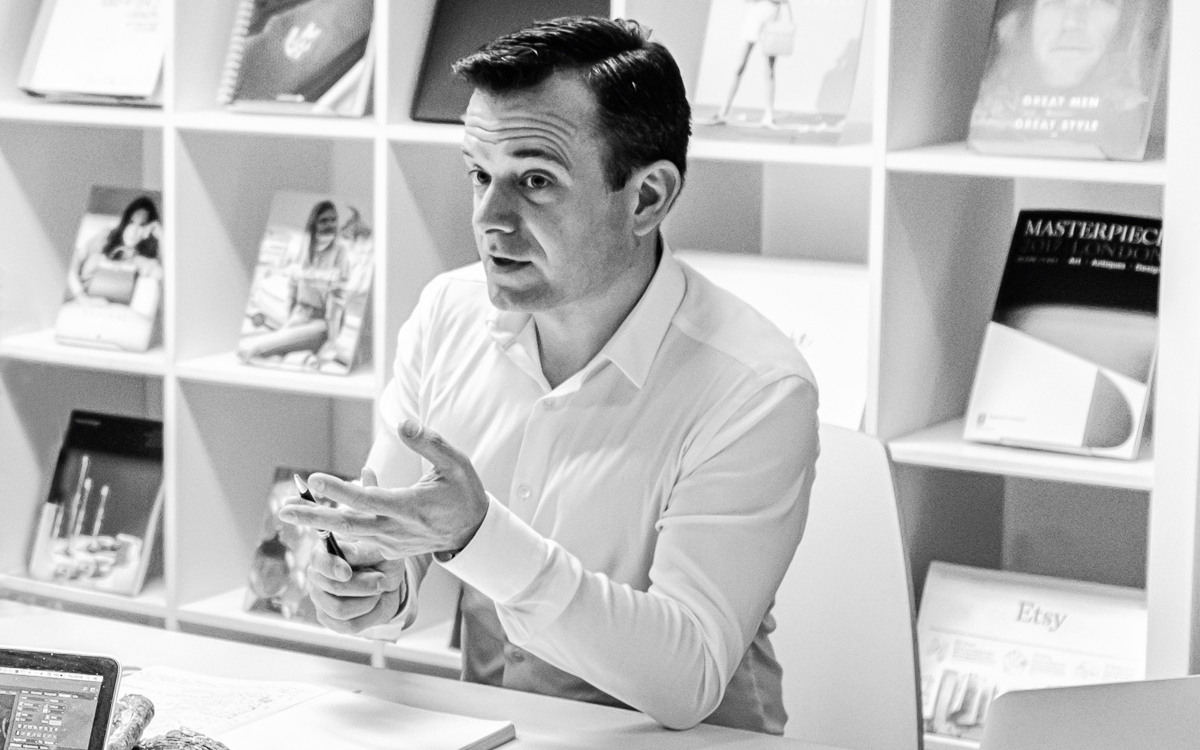
We love to help, and are often asked to recommend the best from outside of our field. We also believe that exceptional work usually comes from collaborating with exceptional people.
Cousin Talks is where our partners and clients share different industry perspectives, topical comment and thought leadership.
If you’d like to contribute please get in touch.

COUSIN MEET 8 was an informal presentation by GF Smith, discussing the findings and insight drawn from their recent ground breaking study. Over 26,000 people were asked to choose their favourite colour, in order to gain understanding into how the role of colour and its interpretation influences us all. The analysis breaks down results by age and gender, as well as by context such as emotion, environment and common associations.
A fascinating evening for anyone with a professional interest or just simple curiosity in the science behind colour, and how it affects our perceptions of brand, mood, function and feeling. Also discussed the colours and triggers associated with innovation, luxury, fashion, beauty, lifestyle, travel, sustainability, seasons, sensations and feelings.
Show less

The state of California alone has a higher GDP than UK. We share a common language. And British brands enjoy a heritage premium amongst our American cousins. At COUSIN MEET 7 David Lockwood shared his remarkable knowledge and insight into marketing to the US consumer, with lively and thought provoking input from a gathering of great British brands.
Many thanks for joining us last night to share your experiences of marketing into the US. We appreciate your openness and hope it was a valuable session for you. The discussion covered a lot of ground so I have shared some of the key points below. All your email addresses are above so you can contact each other if you would like to follow up on specific questions.
PPC is a good channel to start in the US but UK agencies can struggle to understand the differences in the US eg landing pages, reviews. Better to use US based agencies.
AOVs higher in US and response rates also higher in some cases
Britishness sells in the US but you need to work out what British means to your brand. Union Jack? Black cabs and taxis? English country gentleman? London cool? Create a British manifesto for your brand and share with your teams to make sure everyone is aligned.
If you are new to the US, you won’t know what brand messaging will resonate with US customers. Just replicating your UK messaging might not work. Try lots of copy tests on short term Facebook ads to see what works.
Customers for UK brands can live in the big states California, Texas, New York but don’t need to specifically target these regions because lookalike modelling in Facebook, Insta, Data coops for mailings will find the right customers wherever they are.
Mailing works well in the US and there is a lot of data available. There are 5 data coops in the US, each with a slightly different focus.
Make the US mailing piece as efficient as possible eg your best sellers on 4+24 pages. It means you can afford to mail more to make the most of the data opportunity
Catalogue paperweight used in the US is general lighter 80GSM but using heavier paperweight can emphasise Britishness.
Translate language where possible eg. trousers to pants especially for PPC and SEO. The extra cost of a plate change to change £ to $ and some key words is worth it for customer engagement.
Inserts are hard to get to work in the US. They don’t have strict regulation and circulation figures quoted often include free copies. Hard to prove insertion. No one in the group is making inserts work in the US.
Look at how UK competitors are pricing in the US and considering following suit. US customers will pay higher prices for Britishness or uniqueness. Many brands pricing higher in US.
“Angel” in Cornwall used as an overflow to handle US calls in the UK evening. Helloangel. RSVP also a good quality call centre but more expensive. RSVP
Consider using a dedicated number for US acquisition campaigns to track resulting calls separately.
US customers expect free delivery (important for conversion) and want a tracking number. Tracking numbers stop WISMO (Where is my Order) calls. Analysis has also shown that loyalty and LTV increases for customers given a tracking number.
If you have a local US website rather than an extension to the UK site, it can help with US email deliverability.
US customers can have different purchase patterns and buy for different reasons. Eg more people in south buy thanksgiving gifts, people in north buy Xmas gifts. Xmas gift sales don’t usually start until after thanksgiving, tighter window than UK. People give graduation gifts.
Consider how to cope with different weather conditions if you have a weather related offer eg clothes. Can be 20 degrees, 5 degrees and -10 degrees on the same day in different states.
Try to get local knowledge, run your marketing ideas past a US native. Also consider unique US gifting occasions such as college/high school graduation in May. If anyone would like a recommendation of a US digital marketing consultant, I can introduce you to someone who is just starting out, ex Long Tall Sally US.
Show less
Thanks again to Aidy and Debbie from Go Direct for steering us through some innovative and proven techniques to get more customers, and then keep them. And of course to all the brands joined, for your lively and open contributions.
COMPETITION & TRADING
Is increased competition making trading tougher or is it the economy in general?
NEW CUSTOMERS
How many brands rely on new customers to drive growth, or is retention becoming more of the focus?
DATA POOLS
Are these still the most reliable source of cold data and is it currently performing?
INSERTS
Are these coming back as a source of new customers as well as brand awareness and do they work well for fashion brands?
E-MAIL ACQUISITION CHANNELS
What is working best for everyone and does it deliver enough volume of new customers?
NEW ACQUISITION OPPORTUNITIES – PARTIALLY ADDRESSED
Does everyone know about it, who has tested it and what are their thoughts?
RETARGETTING
You invest a lot of cost and effort getting people to visit your site and 95%+ of them leave without purchasing. What retargeting strategies do you have in place to convert some of these?
SALE
Is a sale period a good time to recruit new customers?
DISCOUNTS
Are discount offers the best way to attract new customers?
GDPR
Has this affected everyone’s businesses or was it a bit of an anti-climax?
TO HOLD
PROPENSITY MODELLING vs RFM SEGMENTATION
Who still uses RFM segmentation? Or is modelling the most accurate way to predict mailing volumes?
HACHIKO
How this is performing for clients and why is it such a step change?
RETENTION RATES
Are retention rates falling in general & how is everyone trying to combat this?
REPEAT PURCHASE
How do you encourage customers to purchase a 2nd time and stay brand loyal?
SEASONALITY
Are the seasons changing and should we be launching SS in May & AW in November? Or should all the product within seasons be more transitional?
LOYALTY
Are loyalty points schemes a good way of keeping customers loyal?
PROGRAMMATIC MAIL
Are abandoned basket mailings worth testing to incentivise a purchase via direct mail and what is possible?
E-MAIL SEGMENTATION
Who maximises this and how is it working for them?
PERSONALISATION
We are all unique, just like everyone else. How do you build an intimate customer experience from an online sale?
SUSTAINABILITY
Product ethics are now a key product benefit. How do you tell your story?
Show less
New acquisition opportunities – partially addressed
Does everyone know about it and what are their thoughts?
Data pools
Are these still the most reliable source of cold data and is it performing?
E-mail acquisition channels
What is working best for everyone and does it deliver enough volume?
GDPR
Has this affected everyone’s businesses or was it a bit of an anti-climax?
NEW CUSTOMERS
How many brands rely on new customers to drive growth, especially in the homewares & furniture sector?
REPEAT PURCHASE
How do you encourage customers to purchase a 2nd time or is furniture just an infrequent purchase business?
INSERTS
Are these coming back as a source of new customers as well as brand awareness, and do they work well for homewares brands?
SALE
Is a sale period a good time to recruit customers?
DISCOUNTS
Are discount offers the best way to attract new customers?
RETARGETTING
You invest a lot of cost and effort getting people to visit your site and 95%+ of them leave without purchasing. What retargeting strategies do you have in place to convert some of these?
Propensity modelling
Is this the most accurate way to predict mailing volumes?
Who still uses RFM segmentation?
Hachiko
How this is performing for clients and why is it such a step change?
RETENTION RATES
Are retention rates falling in general?
How is everyone trying to combat this?
Programmatic mail
Abandoned basket mailings to incentivise a purchase via direct mail.
Is this worth testing and what is possible?
E-mail segmentation
Who maximises this and how is it working for them?
LOYALTY
Are loyalty points schemes a good way of keeping customers loyal?
PERSONALISATION
We are all unique, just like everyone else.
How do you build an intimate customer experience from an online sale?
SUSTAINABILITY
Product ethics are now a key product benefit.
How do you tell your story?
Show less

Why reborn?
I say reborn because everyone thought it had been killed by the speed, cost and ease of execution that digital brings.
But print is original mass communication. Its invention provided the economic, cultural, scientific and spiritual backbone that has shaped civilisation. That level of engagement doesn’t go away, as its part of our earliest memories. Recent research by Royal Mail MarketReach shows that the age group who react most positively to receiving print are Millennials, so print has a whole new future!
As with so many things in life, print’s greatest strength is its greatest weakness. But I think the better digital gets, the more important print becomes. In fact, the reason we are seeing a resurgence in print is simply because digital can be so damned good.
Wherever you look people are craving authenticity, and I think this is partly because we are all so bombarded with messages and marketing noise. It’s an endless clamour that you simply can’t avoid, and it comes so thick and fast that there’s no chance to reflect on what’s actually being said. Too much choice is bewildering, and so we are drawn to the real, physical and genuine experiences we can trust and keep.
What examples of that do you see?
Loads, in no particular order: Stationery, bicycles, vinyl, milk bottles, sewing, baking, beards, board games, coffee, Mom jeans, vintage t-shirts, colouring books, candles, craft beer, anti-establishment politicians. OK that last one might be stretching things a bit, but you get my point. There’s actually a shop in New York called CW Pencils that just sells pencils. It opened in 2015 and is still going strong. So that’s a low value, disposable, antiquated, non-essential product with considerable design flaws. How do you make that work from a shop in Manhattan?
Surely that’s not all you attribute to the rebirth of print?
No, I do think the legacy that print has commands a premium. An attention premium, a credibility premium and the ability to frame that crucial first impression. Digital can be amazing, but it’s very difficult to make it cool. What’s less cool than an email?
Because print is used less it is worth more. Anything that is low cost and ubiquitous will always have a perceived low value, and that doesn’t sit well with premium brands.
Where does print sit best then?
Its qualities match many of the values cherished by premium brands. Print can generate a sense of exclusivity, and I think a lot of brands are really worried about how they can remain distinct from smaller, nimbler, challenger brands. Perhaps the bigger worry is how to remain distinct from Amazon / Google, where, by definition, the buying process only leaves the tangible price and flattens the intangible qualities of a product (craftsmanship, heritage, materials, durability and so on).
If the aim of marketing is to tell a story, or to be cynical, sell a story, then you must have the audience’s attention. Print can cut through the noise of all the other advertising messages, as it isn’t corrupted by over familiarity. And there is certainly some kind of link to our basic curiosity that you get when looking through a brochure or catalogue.
So much of personal communication now is macro social, with the likes of Facebook, Twitter and Instagram making everything we do immediately available to a wide and relatively impersonal social group. To receive something that has been artistically considered, expertly crafted and delivered specifically to you is a micro social communication. This feels more like a proper old school conversation, human to human, because you’ve been given something that is real, tactile, sensual and tangible.
The bottom line is it is far easier to tell an interesting story with something physical than something immaterial. And the story is surely the first (and therefore critical) opportunity to build up emotional and aspirational capital with a customer, and that’s the currency of loyalty.
To mangle someone else’s words: “Fashion is an industry driven almost entirely by emotion. How something looks and feels, how it stimulates the senses, is much more important than its function. To make this point all I have to say is ‘high heeled shoes’. If they’re Louboutins that makes my point even more persuasive.”
What do you see as the future for print?
Over the past 20 years the print industry has been shattered, largely due to over capacity from falling demand combining with more efficient manufacturing technologies. We are now in a world where lack of capacity is going to be the problem, as demand is rising and so many Printers have closed. Paper lead-times are getting longer and Printers no longer have the level of flexibility we have all taken for granted. Our best relationships are built around a clear understanding of partnership, both with our manufacturing partners and our customers. We work very hard at this, and I believe this principle will become even more important in the coming years.
Some of the emerging technologies will make a step change in what is possible with personalisation and dynamic content. I’m hugely excited about this as it will give our customers the opportunity to send a physical communication that has genuinely been designed around the individual customer experience. This will be a very powerful and memorable thing for the customer, and will present a new opportunity for brands to give their customers a rational excuse to justify emotional decisions.
This is where I also see print and digital working together, playing to each other’s strengths and compensating for each other’s weaknesses. It is difficult to give a genuine example of this being transformative, but it will be soon. Print X digital is the way forward.
We get very excited by the materials, colour precision and artisan processes in our work. But it’s fair to say that it’s the quality of customer data and accuracy of profiling that really tilts the ROI of a mailing. The advances in these areas have made a huge difference to the numbers. After all there’s no point preaching in an empty church!
When GDPR kicks in next year this will have a huge impact on how brands are able to recruit, incentivise and retain customers. This will also strengthen the hand of print as a media channel, and handled correctly will present a fantastic opportunity.
Show less
What do you think is a common misconception about direct mail as a marketing channel?
A lot of people view direct mail as outdated or only appropriate for retailers who target older audiences. I would say this is untrue, as there has been a recent surge of ecommerce start-ups using a catalogue or direct mail to drive new and existing customers of all ages to buy online.
What is driving this resurgence of direct mail?
Start-ups these days will grow organically through one or several online marketing channels, whether that’s Google AdWords, retargeting or social media. Traditionally, this has been the cheapest form of marketing from a cost per acquisition (CPA) perspective. However, every retailer will eventually find that their growth curve through online marketing alone begins to plateau. Then they begin to explore alternative customer acquisition channels. Many have found that sending a piece of well-targeted print marketing at the right time with the right offer can open up a completely new audience.
How can the cost of direct mail compete with the affordability of online marketing?
Online marketing CPAs are increasing. The actual cost of an online campaign is always going to be cheaper than direct mail due to the cost of print and postage. However, when you look at return on investment (ROI), the results are often surprising. Every single retailer these days runs online marketing campaigns, they’d be mad not to, but this is making for a saturated market, driving the cost up as brands compete for the same customers. In addition, customers recruited online tend to spend less per order than direct mail. The result? Direct mail CPAs are looking increasingly comparable, if not cheaper, than online!
What is the main advantage of employing direct mail as a marketing channel?
Direct mail recruits are more likely than those recruited online to become brand-loyal. This is because a catalogue, “look book” or similar is a great way to convey your brand values and quality to a customer that’s never bought from you before. This explains why they spend more per order and purchase more frequently. Couple this with the fact that direct mail opens up new audiences and helps gain cut through (compare your inbox with your doormat for example!) and you have a recipe for sustainable long term business growth.
Can a business successfully adopt a direct mail marketing strategy if it already runs existing online campaigns?
Yes, and you should be running your online marketing campaigns in parallel with your offline activity. 75% of people that respond to a piece of direct mail do so online. This means, for example, a Google AdWords strategy is needed to ensure they find you if they don’t have your catalogue in front of them when they are ready to buy. The message from the marketplace is simply that incorporating addressed printed marketing into your multi-channel marketing strategy works.
What are some important considerations for a business adopting a new direct mail campaign?
It is important to take advice from companies that can help you to create a profitable first direct mail campaign. By working with the right partners, you’ll avoid the common pitfalls made by direct mail newbies and produce a cost-effective piece of printed direct marketing.
Deciding who to target is just as important to campaign success as deciding on what products go into the catalogue and how it looks creatively. That’s where Epsilon Abacus comes in. We manage the Abacus Alliance, a data co-operative of 500 retail brands who contribute customer transactions on a weekly basis. This is used to understand UK consumer behaviour – how much they are spending, how frequently and in which retail categories. This shared database gives rich insight into shopping behaviour to predict what people are likely to buy in the future so only those likely to be interested in your product are selected to receive a catalogue.
Show less
How does tribalism relate to marketing?
There is nothing new about ‘Brand Tribalism’, after all, the concept has been around since the 80s. Put simply, tribal marketing is the idea that consumer groups are more than just that - consumers. More so, tribal groups are audiences that share beliefs and subscribe to different tribes – purchasing, influencing and promoting different brands across a range of media and marketing channels.
Why is ‘Brand Tribalism’ an important concept for marketers to understand?
In this day and age of fast moving developments in social media and the plethora of marketing channels, tribal marketing should be at the forefront of marketer’s thinking.
We believe that by understanding tribes’ different motivations, habits and beliefs, marketing campaigns can be tailored more effectively to deliver customers exactly what they want from brands.
How so?
On the one hand, it could be considered that our collective behaviors are depressingly predictable. On the other, we at Pixie believe that by creating tailored campaigns to different customer segments, marketers considerably enhance consumers’ brand experience.
After all, who enjoys wading through daily emails of misplaced offers, or filling up the recycling bin with an endless waste of direct mail?
The key is to truly understand your audience in order to create finely judged authentic creative that rings true. This, in turn, reduces waste and increase ROI. Sounds like a win win to me.
Show less
How do you think the emergence of digital and the competitive world of e-commerce have changed the face of luxury fashion?
I have been told recently that "prolific not perfect" is the way to do things these days, as that’s just the way of the very fast paced world of digital. Literally it is suggested that if it is good enough then go with it! However, I believe that as a creative, it can be hard to leave our sense of discipline and get caught up in the speed of things just because everyone else is doing it.
For me it’s actually the complete opposite. It takes time to create quality and some things you just have to wait for.
At what point in your career did you learn the importance of and develop this sense of patience?
I learnt these principles during working for 25 years in the luxury fashion business. The most influential part was the initial 12 years working in Italy, where I learnt the importance of waiting and patience. I worked with artisans and craftsmen - people who take their time creating and take pride in their work – and that really inspired me.
If there is any country that takes time, it's Italy. They take time to just exist. Time to absorb the beautiful culture, amazing countryside, and delicious food. They grow up with an appreciation of quality produce. More than that, they really have an eye for detail.
How do you share in this eye for detail?
I am completely passionate about fabrics. When I worked with Armani in Milan I was incredibly privileged to learn and understand the art and subtlety of them. After a few years of working with him, my understanding and sensitivity was like that of the nose of a perfumer - I could pick a winning fabric out of a thousand very similar fabrics. That takes expertise.
It’s almost as if you have learnt a new language and can understand where others can't. When you get to that level of detail you can see where things are not quite right and where things can be improved. Knowing that in the end, customers really appreciate that extra effort does mean that I find it hard to let things go. I push clients in the same way, to be the best they can be. Its at the heart of the ALIGN principle which I talk about in my new book which will be published this year.
Do you think these principles and experiences can offer competitive advantage in today’s retail market?
Absolutely. In a fast-paced world that is so over-saturated, it's the ones who stay true to their brand values, are consistent, who are attentive to details and deliver one thing exceptionally, that get noticed.
So maybe on social media it's the other way around, but when you deliver a product, perfect not prolific is the key to standing out.

In your opinion, what is the key to success for a B2C business?
Customer loyalty is the main driver of success – successful businesses are built on it. In a consumer facing business, it’s not unusual for 80% or more of profit to be generated from 20% or less of your customers.
What challenges do brands face in attaining and retaining loyal customers?
Unfortunately, buying something from your brand is not the most important thing in your customer’s life. We all know this, but it’s easy to forget when you live and breathe your brand every day.
When your customer makes their purchase decision it’s based on any number of reasons, the thought process behind a purchase of kitchen paper is vastly different to that of a winter coat, but there are a few principles that hold true across the board.
In today's connected world, it’s very easy for customers to shop elsewhere, and if your proposition isn’t memorable for all the right reasons there is no real incentive to come back to you.
Do you have a favourite example of a business that excels in the loyalty department?
Wordery.com. They are an online bookshop and they have no right to exist. Amazon owns books, right?
Wrong – Mrs. D loves them because, “They are nice - you get a bookmark with every order and it changes all the time, you also get a sticker that says, ‘This book belongs to’ on the delivery note.” Mrs. D goes on to say, “They really love books”.
Wordery have gone to extraordinary lengths to distinguish their brand. Their mission is clear: to bring back the enjoyment of buying books and to be a traditional bookshop but with the convenience of an online store. It works - founded in 2012 they now have five million customers in over 100 countries. More importantly Mrs. D goes back again and again, even though we subscribe to Amazon prime.
By building their brand, Wordery are thriving. They deliver a fantastic service, free delivery as standard and have expert knowledge. They are not always cheaper than amazon, but they don’t have to be because like them, their customers love books.
Like Wordery, brands need to find their raison d'etre. Become remarkable and make sure you deliver a wonderful service.
Why do so many businesses struggle with loyalty even if they are competitive within their industry?
Picture the scenario, you sell widgets, they are the best widgets on the market, what’s more the price is very competitive. Not the cheapest, but certainly not the most expensive. For the discerning consumer of widgets, you are the natural choice, but over 60% of your customers only buy from you once and you never see them again.
This makes running your business expensive - you are spending vast amounts of money recruiting new customers, yet your customer base isn’t growing, and you need to understand why. Ask yourself:
Why should your customers return to you?
What barriers do you have in place?
Did the original widget purchase go well?
Are they really ‘your’ customers, or did you simply rent them from someone else?
Are your customers really motivated to be loyal to the widget emporium?
Did you buy the original sale and if so can you buy loyalty?
How can a brand go about achieving success through loyalty?
The key is to create a memorable customer experience by concentrating on 5 key areas:
As a retailer, you need to get at least 3 out of 5 to succeed - ideally you need to hit all five.
Wordery doesn’t have a unique product, but because they tick the other 4 items, they are able to succeed despite Amazon dominating their sector.
Show less

How would you describe the struggles of manufacturing partnerships in Asia?
When people discuss manufacturing in Asia, they all too often focus on negatives; stating that suppliers are difficult to deal with, untrustworthy and unreliable. Having spent the last 5 years developing strategic production partnerships with suppliers in this region, I have come to understand that this point of view tends to be grossly unfair and can often be traced back to the buyer and the lack of investment that has been made in the trading relationship.
In what way can the buyer themselves be to blame for negative manufacturing outcomes?
Most complaints about suppliers in this region is that they look to cut corners – they use sub-standard materials, allow for too little wastage forcing them to loosen QC procedures, ignore environmental standards, and delay deliveries.
While these issues occur on an all too regular basis, what tends to be ignored in the aftermath is the pre-production negotiations - where customers relentlessly push for lower costs, playing multiple vendors off against one another, often dishonestly. As a result of this, suppliers may offer pricing that is below their actual cost to win work, forcing them to then cut corners during production in order to turn a profit.
Although this pricing initially looks great, the question of how pricing came to be so low only arises when it is too late. In these instances, the cost of correcting a sub-standard product, extensive QC checks, and the delays that go with it, always outweigh any initial savings that were worked towards in the first place.
How does this job negotiation process affect ongoing buyer/vendor relations?
This has led to many suppliers having a very short term view towards winning work from western clients, usually thinking about jobs on an individual level with little regard for the ongoing relationship. As a result, it has become all too common to find a situation whereby the customer does not trust their supplier and the supplier, in turn, does not trust their customer, making for very difficult and ultimately unsuccessful relationships.
What can the buyer do to promote successful relationships?
The best way to avoid this conflict and provide a more open and ethical supply chain is to develop longer term strategic partnerships with a smaller range of suppliers.
The relationships I have established over the last few years here in China allow us to better understand a supplier’s cost model and to work alongside them to ensure they consistently meet the high standards our clients demand. If there is ever any issue with prices, timings or quality we are able to identify and address them early with both the supplier and the end client, ensuring that together we come up with the best solution for all. Without this open dialogue, the supplier is more likely to try to find their own way to resolve any issues, often with disastrous consequences.
How else can building strategic partnerships contribute to the success of the overall manufacturing process?
In addition to avoiding conflict, these relationships allow us to consult the supplier much earlier on in the design process. By doing so, we are able suggest alterations, which often greatly improve the cost, quality and/or functionality of the end product. In addition to this, we are also one of the first to know of any new products or innovations that suppliers develop. This free flow of information fosters a direct benefit for all. While these relationships take time to nurture, manage and develop, they unquestionably pay off in the long-run.
Show less





















































































